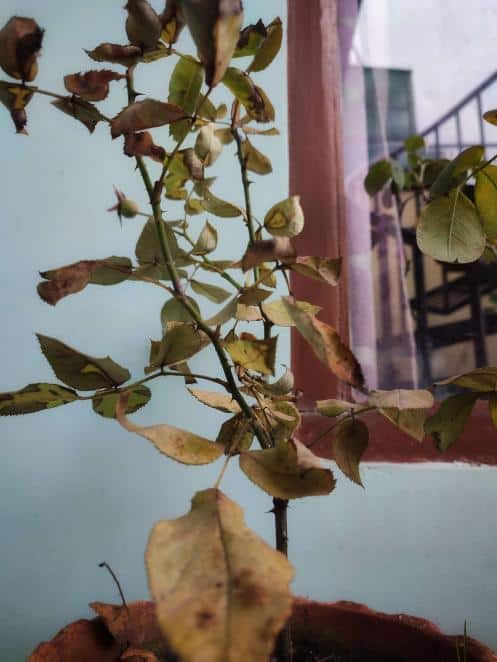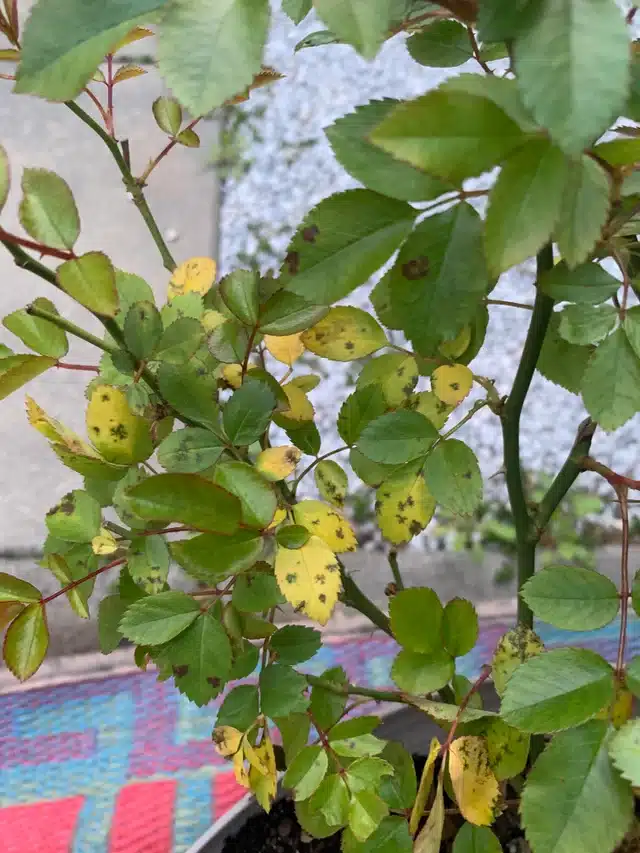Green leaves always promote the healthy growth of roses, but if there are pale or yellow leaves, there must be wrong with the plant.
Normally, roses’ leaves turn yellow during winter. As they stay dormant during winter, the leaves turn yellow and fall during the winter season.
However, if the roses get yellow leaves only due to cultural factors, you must act against them.
Table of Contents Show
What Causes Yellow Leaves on Roses?
It is also normal for the rose to have yellow leaves when the plant is about to die after its natural age. Besides, roses can have yellow leaves when leaves turn old and are about to drop.

We cannot act against the natural age of roses and leaves.
However, other than the natural age, there must be some wrong things if the yellow leaves of a rose appear.
1. Improper Watering
Yellowing of rose leaves occurs both due to underwatering and overwatering.
Underwatering can lead to yellowing rose leaves of rose when the roots fail to deliver adequate nutrients to the plant.
You can tell that your rose is underwatered if the soil around it is dry and the leaves turn dry and crispy.
Furthermore, the leaves begin wilting and dropping when it does not get adequate water.
If you water a rose plant above its tolerance, its roots begin rotting, preventing the rose from receiving essential nutrients. Consequently, yellowing of the leaf occurs.
In addition, if you leave water in the rose bushes intact, the sunlight gets reflected towards the lower leaves, and there is a high chance of burning those leaves.
Although roses love water, they do not prefer soggy soil.
The roots of an overwatered rose plant are black and mushy, and the soil produces an odor.
Practical Solutions
Rose plants prefer a soak-and-dry method of watering. Water your rose plant weekly during spring and every three to four days during the summer.
Consider the following advice to devise your stressed rose.
| Underwatered Rose | Overwatered Rose |
|---|---|
| Make some small holes in the soil. Pour the water through the holes till the soil is damp. | The first step is to stop watering once you notice the signs of overwatering. Water the rose only after the soil is dry. |
| If your plant is in a container, pour water until the water passes out of the drainage holes. | Move the overwatered plant to shady place. Doing this help prevent the upper part of the leaves from drying out. |
| Break the dry soil using a fork and dip the pot in lukewarm water. Leave the container till the air bubbles begin to appear. | Loosen the wet soil and roots to allow them to dry quickly. |
| If the soil feels still too dry, you can repot the plant in moist soil. | If the soil does not dry, throw away the soil and repot the rose in a new container with drainage holes and fresh soil. |
| Placing the plant in a water-filled pebble tray can also help overcome the underwatering. | Repot the rose plant during early spring or late spring once 2-3 years. |
2. Insufficient Lighting
Roses need full and direct sun.
When you don’t provide adequate sunlight to the rose, the flowers often do not bloom, and the leaves turn yellow due to deficient chlorophyll formation.

The lower leaves of the rose do not receive adequate sunlight, so they turn yellow and later drop.
Practical Solutions
If your rose plant in a shady location is turning yellow, help your plant with these immediate steps!
- Place your rose plant in a sunny location.
- Bring out the rose outside if you have grown the rose in a pot indoors.
- Cut or remove anything above the rose plant that has shaded over it.
- Rotate the rose so that each side of the plant receives the light.
- Unveil the curtain over the rose plant.
- Plant or place the roses in an area where they receive full sun exposure for at least 6 hours a day.
3. Fertilization Problem
Rose plants need heavy food, and if you have grown them in containers, you need to pay special attention when fertilizing.
Generally, the yellow coloration of rose leaves occurs due to the deficiency of nitrogen, magnesium, and iron.
Besides yellowing, leaf tips curling, and plants’ stunted growth occurs due to nutrient deficiency.
Nutrient deficiency in rose plants occurs due to inadequate nutrients in the soil or incorrect soil pH.
The frequency of fertilization depends upon the variety of the roses.
You can consider the rose to have overfed when a crust of fertilizer develops over the soil surface.
Furthermore, other symptoms of overfertilization are blackened roots and browning of leaf margins.
In addition, iron deficiency occurs when the soil has too much clay, is too wet, or has a high phosphorous content in the soil.
Practical Solutions
Use composts for a recently planted rose, and feed it with balanced fertilizer about a month after planting. Repeat fertilization every 2-3 weeks for the adult rose.
- Adding nitrogen fertilizer, adjusting the soil with animal dirt, or any compost will help supply nitrogen to the soil.
- Add Epsom salt to the soil to compensate for magnesium deficiency.
- Apply peat moss and compost to amend clay soil.
- Use chelated iron as a supplement to the soil.
- Use the coffee grounds to compensate for the nutrition in the rose.
- If you notice the symptoms of overfertilization in your rose plant, remove the layer of fertilizer formed over the soil surface.
- Wash the fertilizer away from the soil with running water. Repeat the process till excess fertilizer is washed away.
- Remove the yellow leaves; do not fertilize the plant until one month.
- If these steps don’t work, transfer the root to another soil mixed with a balanced fertilizer.
4. Heat Stress
Though roses are sun-loving flowers, extreme heat and dryness can be dangerous to them.
Rose plants show yellow leaves in their bushes when the soil cannot retain moisture due to direct heat on the plants.
They drop their yellow leaves to cool off the heat.
The use of mulch is the best way to revive the rose from yellow leaves due to heat stress.
To prevent further yellowing of leaves, you should cover the soil with a layer of mulch to preserve the soil’s moisture.
Practical Solutions
Rose prefers a temperature range between 60 and 70 degrees Fahrenheit which is ideal for roses.
If the heat is severe, follow the following instructions!
- Hydrate the rose if it feels warm.
- Maintain air ventilation for the rose if it is stuck in the warm surrounding.
- Use the extension to cover the rose with the curtain above the rose to disallow the excess light.
- Place the potted rose under the big tree to allow some shade.
5. Incorrect Soil
The rose flowers prefer slightly acidic soil of pH 6 to 6.5. With alkaline soil, roses can not uptake essential nutrients like iron, phosphorus, and magnesium.
If the soil pH is above 7, which represents alkaline, a rose plant displays yellowing of leaves.
Roses need rich loamy, and well-draining soil, and they hate soggy wet soil.
Practical Solutions
If your soil pH tests alkaline, you can save further damage to roses through these steps!
- Transplant the rose into the acidic soil. If acidic soil is unavailable, you can add peat moss to the topsoil to make it acidic.
- Add ground agriculture lime to allow the soil to be slightly acidic.
- Use aluminum sulfate and sulfur to lower the pH level.
6. Pest Infestation
The rose plants often get infested with pests like aphids, Japanese beetles, rose sawflies, spider mites, and others.
When the pests feed on the rose leaves, you can see holes in the leaves, and the leaves begin turning yellow.
Practical Solutions
You can rescue your pest-infested rose plant with the following steps!
- To kill aphids, you can apply a home-based DIY in which you should mix one tablespoon of soap with one liter of water. Spray this solution on the rose plant for a few days.
- Spray rubbing alcohol or neem oils over the pest-infested leaves to kill spider mites and aphids.
- Pick the larvae of rose sawflies using a hand or Q-tip dipped in isopropyl alcohol.
7. Attack of Diseases
Larger rose shrubs are less susceptible to diseases, whereas smaller varieties, including tea roses, have a higher chance of destruction. Thus, miniature roses turn yellow in leaves faster than large roses.
Black spots, Rose Mosaics, Downy Mildew, Botrytis Blight, Rust, and Rose Rosette are common diseases that attack a rose plant and cause its leaves to turn yellow.

Practical Solutions
Fungal and bacterial diseases occur when the humidity is high around the rose. Relative humidity of 60-70% is good enough for rose plants.
Conduct your action against the diseases as soon as you identify them.
- Treat the signs of black spots using a fungicide containing chlorothalonil.
- You can prevent the further spread of black spots by removing the mulch.
- Allow faster drying of the leaves, and do not water the plant during the afternoon or evening.
- Fungicide-containing Metataxyl helps to cure Downey Mildew.
- Fungicides containing sulfur can be useful to minimize the effects of rust on the leaf.
- You should provide good air circulation to the plant to prevent the spread of rust in rose leaves. Prune the plants regularly to ensure air circulation.
Should I Remove Yellow Leaves from Roses?
Removing the yellow leaves encourages the new leaves’ growth and prevents the growth of fungi, pests, and diseases in your plant.
You must prune the rose bushes in the early growing season, usually early spring.
Start with the following steps!
- Wear gardener gloves to protect your hands, and use sterilized pruners to cut the leaves.
- Choose the yellow leaves and remove them from the base with the help of pruners.
- Only prune the pale leaves. Do not remove the healthy leaves from the plants.
- Collect the pruned leaves in the container and keep them to make compost.
From Editorial Team
Grow hardy roses to skip the tight care schedules!
Wild roses always stand hardier than cultivated and hybridized types.
Other than normal ones, you can grow roses, including Bukavu, Cinderella, Crazy Love, Distant Drums, Hot Paprika and James Gallaway.
